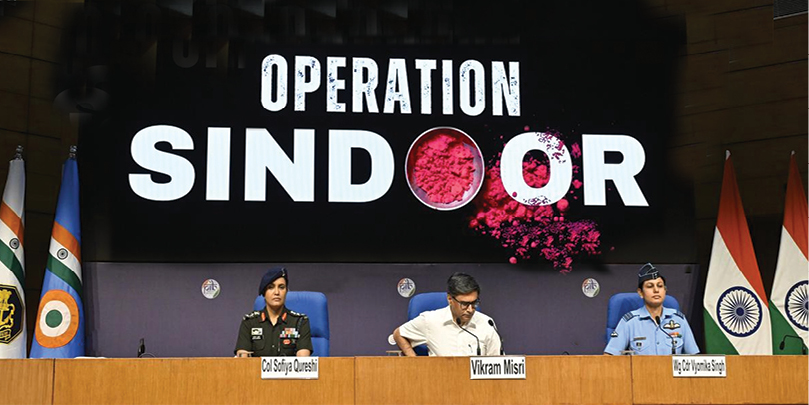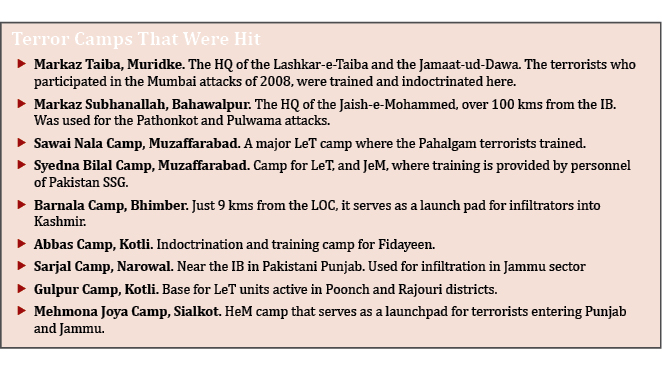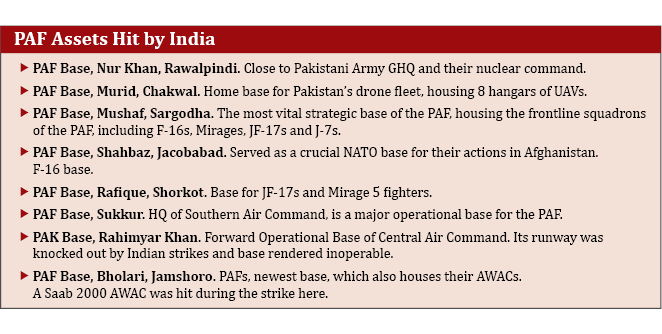
Articles
EVALUATING OP SINDOOR
Sub Title : A brief recap on all aspects related to Operation Sindoor
Issues Details : Vol 19 Issue 2 May – Jun 2025
Author : Ajay Singh
Page No. : 26
Category : Geostrategy
: June 3, 2025

Operation Sindoor marked a decisive and high-impact response by India to the Pahalgam massacre, signalling a shift in strategy against Pakistan-sponsored terrorism. From diplomatic isolation to precise military strikes, the operation reshaped regional dynamics, highlighting India’s evolving deterrence posture and its resolve to impose costs for cross-border terrorism.
The horrific massacre of 26 civilians in the beautiful Baisaran meadows of Pahalgam, on 22 April had hit the psyche of all Indians and set back the process of normalcy in Kashmir by years. The retribution for that gruesome strike by terrorists, trained and sponsored by Pakistan, had to be coming – and in more ways than one. India cancelled the visas of all Pakistanis, declared the personnel in their consulates as non-gratia and halted all trade between the nations which amounted to a sizeable Rs 4900 Crores per annum. In its most hard-hitting step, India suspended the Indus Waters Treaty of 1960 – which had held through three wars and twenty years of Pakistani sponsored terrorism – virtually choking Pakistan’s most sensitive jugular. These were non-kinetic measures which set the tone for the actual response which came 15 days later, when Indian jets and missiles struck nine terrorist camps deep within Pakistan. That action, and the exchange of fire that followed in the next 96 hours, saw virtually the entire western border being activated. Fortunately, the climb up the escalatory ladder was halted before the conflict could truly get out of hand. But it has changed the dynamics between the two nations – perhaps irrevocably.
The Strike
On the night of 7 May, a strike package of IAF Rafales, Mirage 2000s and Sukhoi 30 MKI fighters launched a precision strike on terrorist camps within Pakistan, firing SCALP Storm Shadow long range cruise missiles and Hammer air-to-ground precision bombs, which were launched from well within Indian air space. Long-range artillery using precision guided munitions were used for targets closer in range. Other aircraft simulated activity all along the front to divide enemy reaction. The entire operation was controlled by an Airborne Early Warning and Control aircraft, while loitering drones sent back videos of the strike and the damage, before they too finally crashed into their designated targets with their explosive payloads.
The entire strike lasted just 24 minutes – from 01.04 am till 01.30 am. By the time it was over, 24 missiles had hit nine terrorist camps – five in POK and four in Pakistani Punjab. These included the Sawai Nala training camp at Muzzafarabad, the Bilal camp in POK, the Gulpur camp in Kotli, the Barnala camp in Bhimbar, the Kotli Abbas camp and the Sarjal camp in Sialkot – all around 9-30 kms deep. The more significant targets were deeper in Pakistani Punjab. Markaz Taiba camp in Muridke, near Lahore – the HQ of the Lashkar-e-Taiba – from where its chief Hafiz Saeed, planned the Mumbai blasts and other terrorist attacks – was levelled with a high precision missile strike. At Bahawalpur, over a 100 kms deep, the Markaz Subhan camp, HQ of the Jaish-e-Mohammed was similarly eradicated. Over 90 operatives were reportedly killed in this strike. The losses had been confirmed by radio intercepts and messages, and the funerals of the dead terrorists. But it is telling that Pakistani officers and politicians were present for their funerals – a indictment of the deep nexus that exists between them and the terrorist groups they have raised and sponsored.
The exact details of the strike are still not clear, but around 70 – 90 aircraft, armed with a variety of munitions, would have participated. Pakistan states that it had detected the strike with their Air Defence systems and claims to have shot down 3 Rafales and two other aircraft, but without any substantive proof. As per the Pakistani Defence Minister, “It is all over social media.” There would have been some damage to equipment, but not a single pilot was lost, and more importantly, the strike hit the designated targets with precision and impunity, inflicting considerable damage and sending across a clear statement of intent.
The Escalation
Pakistani reaction came the very same day. At around 2030h, Pakistan targeted 15 military establishments all the way from Bhuj to Srinagar, striking with drones and missiles. The very next day – on 08 May, the conflict escalated even further as Pakistan fired over 500 missiles and drones at military and civilian locations. The missiles were intercepted and shot down – 8 in the Jammu region itself – but a number of drones did get through, inflicting localised damage. It was the first time since 1971, that both sides had targeted each other’s cities – something that was not done even during the Kargil War. That same afternoon, India attacked Pakistani military installations at Rawalpindi, Gujranwala, Miano, Bahawalpur, and as far as Karachi, destroying the HQ-9 Air Defence system at Lahore with Harpy Kamikazi drones. And on 09 May, Pakistan launched its third round of attacks using around 300 drones – most of them Turkish built Songars – in a strike directed at 26 installations along the western border. By then, the ceasefire along the LOC had also broken down completely and artillery and mortar duels and small arms firing was raging along its entire frontage.
What changed the situation was a major strike that India launched on the night of 9/10 May. Six PAF airbases were hit in a series of devastating strikes with missiles and drones. These included the Nur Khan airbase at Rawalpindi, which was located close to their nuclear stowage plant at Kirana Hills – just 10 kms away. The shock of the explosions could be heard as far as Islamabad, and led to fears that their nuclear weapons had been targeted, and forced a radioactive sweep of the area, to check for any leakage. Chakwal, Sargodha, Shorkot, Jacobabad, Sukkar, Jacobabad, Bholari and Rahim Yar Khan were also hit. Rahimyar Khan was hit by a series of missiles – most probably Brahmos – which damaged the runways and hangars rendering them inoperable. In conjunction with these strikes that radars at Sialkot, Pasrur and Chunian were also hit, virtually blinding their air defence. Subsequent satellite photos revealed extensive damage though losses to aircraft could not be ascertained.
Perhaps the effect of these strikes led Pakistan to ask for a ceasefire, and the two sides agreed to stop all firing from 1700h on 10 May. The circumstances behind the ceasefire have different versions. President Donald Trump tweeted that he had asked the two sides for a ceasefire, and claimed credit for it – a claim that later proved unfounded. Both sides claimed that the other had asked for it. The truth possibly lies in between.
But it was for the best that the hostilities ended at that juncture. Beyond that, would have been counterproductive. This four-day conflict was fortunately, a ‘non-contact battle’, but the Indian navy was in position around Karachi, and ground forces had deployed around the borders. Further escalation could have led to all-out war and beyond that, a climbdown would have been more difficult.
The Aftermath
India has made a clear statement of intent that Pakistani sponsored terrorism would not be condoned, and its response could impose severe costs on Pakistan. It has proved its ability to hit deep into Pakistan, and called its nuclear bluff. If Uri and Balakot set the trend for immediate retaliation into enemy territory, this muscular response has raised the benchmark considerably.
Both sides have claimed victory. But for Pakistan, the victory lies in the fact that its people have once again united against their traditional enemy, India. The army – which had lost much of its sheen and had become increasingly unpopular – has once again been projected as the only saviour of its people. That is something they will capitalize on, even as the impoverished nation lurches from one crisis to another.
This outbreak of open hostilities will now spell a new norm in Indo-Pak ties. Even with the ceasefire in place, there will be considerable tensions for some time to come. Troops on both sides are already deployed along the International Border, and though the ceasefire is in place, they are likely to remain there for some time to come. But the LOC will become far more active. There is also likely to be an increase in cross-border infiltration and India will have to be prepared for further terror attacks, not just in Kashmir but across the country.
But the situation can be turned to advantage. The bulk of the Pakistani army has now been drawn to the Eastern borders, and has created a huge gap in their counter-insurgency operations in Baluchistan and Waziristan. It is no surprise that Baloch freedom fighters and the TTP have intensified their activities in the two provinces, with virtually an attack every day on Pakistani forces. Prominent Baloch leaders have even announced ‘The Republic of Baluchistan,’ and appealed for recognition from India and the United Nations. It is something that should be capitalised on. India’s outreach to the Taliban regime in Afghanistan has also ensured their support for India. Pakistan’s fault lines are already wide, and perhaps this round of open hostilities and growing tension with India could help create a rupture.
The suspension of the Indus Waters Treaty is another action that can hurt. India does not have the ability to completely control or divert the waters of the Indus, Jhelum and Chenab. That will require the construction of massive infrastructure – the equivalent of making 22 dams, each the size of Bhakra-Nangal – which will not be feasible. But there are other actions that India can take. With the treaty in abeyance, we are no longer bound to inform Pakistan of the release of water from catchment areas on our side. Waters could thus be released at random, upsetting the entire cropping pattern in all of Pakistani Punjab. We can also enhance the stowage capacities of existing infrastructure, like the Baglihar, Kishenganga and the Salal project to harness the waters of the Jhelum and Chenab. And the Tulbul navigational project and Wullar Barrage on the Jhelum River – which have been repeatedly stalled by Pakistan – can finally be implemented. This will considerably enhance agriculture and hydro-electricity in Kashmir. All this will take time, but even if the treaty is not abrogated, its resumption could be made contingent on Pakistan’s good behaviour.
However, a great cause of concern is that we were unable to get our narrative across. Most of the western media completely followed the Pakistani line, touting imaginary victories and projecting them as successfully standing up to a larger adversary – a line undoubtedly fed by the Pakistani ISPR. The fact that the entire action was part of India’s war against state-sponsored terrorism was almost obscured. In fact, at the height of tensions, Pakistan received a $1.3 Billion bailout from the International Monetary Fund. Ironically, the bailout was linked to its good behaviour and fiscal management. But almost immediately, Pakistan announced a whopping 18 percent increase in the defence budget, and provided Rs 12 Crores as “Relief compensation” to Masood Azhar– a UN designated terrorist. Another matter of concern has been President Trump’s outlandish proposal to mediate in the issue – something that will again raise the Kashmir issue in international forums. It is telling that the Indian government has refuted this call, insisting that the only discussion would be on the return of all of POK.
India has degraded Pakistan’s military capabilities, eliminated terrorist camps, and demonstrated its reach. We have also made a statement to Pakistan that Indian response will be hard and could even pose an existential threat to them. That should serve as a deterrent for a while. But we cannot afford to let our guard down. If anything, our intelligence and internal security needs to be heightened. The ball in now in Pakistan’s court. It is unlikely to change its ways, but it would be well warned of the dangers of sponsoring terrorism on Indian soil. If that message drives home, OP SINDOOR would well and truly have attained its aims.




